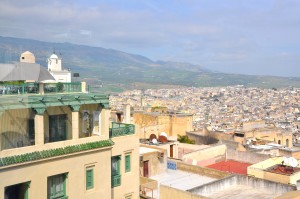You haven’t seen an old city until you’ve visited the medina of Fes. Tiny alleys merge into markets that lead into gardens and courtyards. To walk its cobbled, winding streets is to step back into another time. Fes is one of the four Imperial Cities of Morocco, cities that were each the capital of the region at some point in its history. (Fes has actually been the capital six different times since its founding around 800 AD.) These days, it’s Morocco’s third largest city with a population of around 1.2 million inhabitants. In case you were wondering, the name Fes does not come from the red, tassled Turkish hat. Some say the hat got its name from Fes, others claim it came from a Berber word for the nearby atlas Mountains. Either way, you’ll see plenty of fezzes in Fes as you wander through both the medina, or old city, and the newer French district.
Fes received roughly 380,000 visitors in 2014 and has a bed capacity of 9,200. Like the rest of Morocco, the majority of its visitors come from Western Europe. The Medina itself, now a UNESCO World Heritage site, is split into two parts on either side of a small river, the Andalous and the Quarawiyyia. The medina as a whole encompasses more than 740 acres and has over 9400 streets snaking their way amongst the souks, palaces, fountains, and schools. Legend has it the medina was designed this way to confuse possible invaders. Unlike the Marrakech medina, there are no motorbikes here, no taxis. The only transport is by animal cart. But if you hear someone calling, “Balak!” get out of the way because a donkey can still pack a wallop.
On most Morocco itineraries, Fes is only given a day, maybe two including the nearby Roman ruins, which are a day in themselves. Of course, one day is never enough and you’ll barely scratch the surface but making the trip to Fes even for just one day is absolutely worth it. Plan your day well and you can still see some amazing sights. Here are a few you can’t miss:
In the Medina: The medina is huge and you will get lost. If you can, hire a guide* who knows their way around and you’ll save precious time. Separate areas of the medina are dedicated to different industries or crafts. You’ll find carpets in one neighborhood, fruits and vegetables, leather goods, etc. in another. The leather goods area is easy to find, especially in summer—just follow your nose. Because it isn’t just shops, the actual tanneries are located within the old city walls. Enter through one of the street level stores and go up a few flights—all the while passing gorgeous handbags and jackets—and you’ll come to a veranda area overlooking backyards which are full of vats with different colored dyes. The shopkeeper will supply you with a sprig of mint to keep the smell down. (Really though, it’s only bad in high summer.) All over the nearby rooftops you can see the hides drying, mainly goat and camel. After you’ve had your fill, go back down and try your hand at haggling down the price on that bag you liked.
Also located within the medina, southwest from the tanneries, is al-Qarawiyyin University, the oldest continually operating university in the world according to both UNESCO and Guinness World Records. While you can’t go in, there are several openings along walkways where you can peek into courtyards.
The Royal Palace of Fes, or Dar el Makhzen is closed to the public as well but the exterior alone is worth a look. Intricate tilework surrounds huge gold leafed doors. Follow the road to the right of and alongside the Palace and you head into the former Jewish quarter of Fes, or mellah, so named for the salt that was sold along the streets. Unlike the majority of medina buildings, which are quite plain on the outside with few windows, in the Jewish quarter there are long balconies facing the street, not unlike those of New Orleans. There is no longer a Jewish community living within the medina but the historical buildings can still be visited.
Certain industries, such as pottery, were moved out of the medina and into the surrounding areas due to health and fire safety concerns. Many are open to the public and have small shops inside, where you can buy anything from a tiny eggcup to a full-size garden fountain. The pottery is still made and painted by hand, and you can see the mosaics being created the same way they were a thousand years ago.
And that’s probably as much as you can fit into a day. Watch the sun set behind the green hills surrounding the city, and as you drive back to your hotel you’ll see local people gathering along the city walls, sitting and talking or just strolling, taking in the last rays of the day’s sun.
Where to Stay: The beautifully restored Palais Faraj is perched high above the old city, just inside the medina walls. The hotel used to be a judge’s palace and now is made up of 25 suites, a spa, two restaurants, and a glassed-in bar with a gorgeous view. Many original details remain creating an ultra-luxe but thoroughly Moroccan esthetic. Don’t miss the gorgeous library or the intricately tiled courtyard. Rates begin at €190 for a Junior Suite.
Morocco Tourism: www.visitmorocco.com
*Special thanks to my guide, Aziz (zgani.aziz at hotmail.fr), without whom I might still be wandering through the medina.

